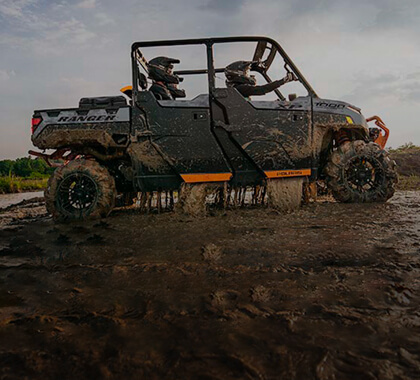Basic Care Guidelines for your Polaris Ranger
May 22nd 2018
The crisp air of early morning jerks you awake as you trudge out into the day’s first glimpses of sunshine. With gloves warming your work-worn hands, you wake your favorite Polaris Ranger from its slumber. The day ahead is full of chores and responsibility, but as you park your rear behind the steering wheel and putter out to meet the day, somehow it doesn’t seem all that bad. After all, with your Polaris Ranger, no job is too big.
While the Polaris Ranger takes good care of you, acting as your trusty sidekick on the best and worst jobs, it’s crucial to keep your UTV in tip-top shape for the long haul. Your Polaris owner’s manual will include details regarding maintenance intervals and suggestions for upkeep, but if you’re looking for a quick reference, look no further than the list below. From the time you get it home to the day you have to retire the old workhorse, you want your Ranger by your side when you need it most. Follow the servicing guidelines below to ensure a long life of great service.
The First Few Rides
Before that first test drive—because we know you’ll want to take it for a spin as soon as you’ve got the keys in hand—check over your Polaris Ranger to make sure nothing was damaged in transport. Are all body panels intact? Do the tires hold air? You can be as thorough as you please, but most companies will not hear any sort of complaints if you’ve already put a few miles on.
Then, hop on and test it out!
After the first few uses and each use thereafter, do a visual inspection of everything you can see to make sure there are no loose wires, no broken parts of any kind, and that your tires and wheels are working as they should. It’s always best to take the few extra minutes to clean off any mud or water that might have dirtied your Ranger, especially around sensitive electrical parts. An extra couple of minutes here and there will add years to the life of your Polaris Ranger.
The First Month
After about a month or 20-25 hours of runtime, you’ll want to look at the following to make sure your Ranger is in proper working order. Again, these recommendations can be found in your owner’s manual, but here are the critical components you’ll want to pay attention to:
- Inspect your brake pads to make sure they are working effectively. If you feel that your Ranger is taking longer to stop, be sure to check the wear on your pads, as they might need to be replaced.
- Check your battery for any signs of corrosion. Clean if necessary, and test to make sure battery is in working order.
- Ensure your air filter is working properly and clean if clogged.
- Inspect all fuel lines to make sure there are no leaks.
- Check all fluid levels and top-off if necessary.
- Perform an engine oil change.
- Check tires for any punctures or slow leaks. Repair/replace tires if necessary.
- Lubricate all fittings, pivots, and cables as needed.
Depending on the terrain you’re driving on, it might be a good idea to check any parts of the Polaris Ranger that get wet on a consistent basis. This includes the driveshaft. Moving parts need lubrication to function properly, and this will ensure you get full use out of the product and may even extend its lifetime.
Seasonal Suggestions: In and Out of Storage
For those Polaris Ranger owners who use their UTVs seasonally, it’s always a good idea to prepare your UTV well for storage, and then do a thorough once-over when you take it out again. Depending on where you store your Polaris Ranger, you’ll want to make the appropriate modifications to the UTV before storing. Controlled temperature environments will support minimal preparation, but always keep in mind how long you estimate the Polaris Ranger will be stored, and prepare accordingly.
Along those same lines, it is best to check all fluid levels and replace completely if necessary. This includes the engine oil. If you’re pulling your ute out of hibernation, it’s a good idea to change the oil because it’s been sitting for an extended period of time. Polaris recommends changing every 6 months or 100 hours of runtime anyway, so chances are you’re probably getting close to that interval already.
Beyond maintaining proper general care of your Polaris Ranger by cleaning it after each use and inspecting for issues, following the guidelines above will protect your investment and keep your UTV in service. Read up on more proper care tips in your owner’s manual, or visit your local Polaris dealer and inquire within if you have questions. Many dealers will offer service packages if you’re strapped for time and/or space, but for those DIYers out there, keep the care tips above in mind, and you’ll be set! Your trusty sidekick Ranger will be there tomorrow for the next job—and the next, and the next, and the next.

